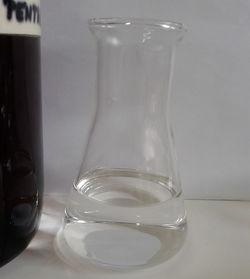Pentane
 Distilled lab-grade pentane.
| |
| Names | |
|---|---|
| IUPAC name
Pentane
| |
| Preferred IUPAC name
n-Pentane | |
| Systematic IUPAC name
n-Pentane | |
| Other names
Amyl hydride
Pentan Skellysolve A | |
| Identifiers | |
| Jmol-3D images | Image |
| |
| Properties | |
| C5H12 | |
| Molar mass | 72.15 g/mol |
| Appearance | Colorless volatile liquid |
| Odor | Lighter-fluid like |
| Density | 0.626 g/cm3 |
| Melting point | −129.8 °C (−201.6 °F; 143.3 K) (decomposes) |
| Boiling point | 36 °C (97 °F; 309 K) |
| 0.04 g/L (at 20 °C) | |
| Solubility | Miscible with chloroform, ethanol, hydrocarbons |
| Vapor pressure | 57.90 kPa (at 20.0 °C) |
| Acidity (pKa) | ~45 |
| Viscosity | 0.240 cP (at 20 °C) |
| Thermochemistry | |
| Std molar
entropy (S |
263.47 J·K−1·mol−1 |
| Std enthalpy of
formation (ΔfH |
−174.1–−172.9 kJ/mol |
| Hazards | |
| Safety data sheet | BOC |
| Flash point | −49 °C (-56.2 °F; 224 K) |
| Lethal dose or concentration (LD, LC): | |
| LD50 (Median dose)
|
3,000 mg/kg (dermal, rabbit) 5,000 mg/kg (oral, mouse) |
| LC50 (Median concentration)
|
130,000 mg/m3 (mouse, 30 min) 128,200 ppm (mouse, 37 min) 325,000 mg/m3 (mouse, 2 hr) |
| Related compounds | |
| Related compounds
|
Butane Hexane |
| Except where otherwise noted, data are given for materials in their standard state (at 25 °C [77 °F], 100 kPa). | |
| Infobox references | |
Contents
[hide]Properties
Chemical
Pentane, like other hydrocarbons, will burn in air when ignited by an open flame to release carbon dioxide and water vapor.
- C5H12 + 8 O2 → 5 CO2 + 6 H2O
Like other alkanes, pentane undergo free radical chlorination:
- C5H12 + Cl2 → C5H11Cl + HCl
Such reactions are unselective; with n-pentane, the result is a mixture of the 1-, 2-, and 3-chloropentanes, as well as more highly chlorinated derivatives. Other radical halogenations can also occur.
Physical
Pentane is a colorless liquid hydrocarbon, with a characteristic smell. It is insoluble in water, but miscible with other organic solvents. Pentane has a density of 0.621 g/cm3, meaning it's lighter than water. It boils at 36 °C and melts at -130 °C.
Its isomer neopentane, though, is a gas that boils at 9.5 °C, is the heaviest and the most high-boiling of all hydrocarbon gases.
Availability
Pentane can be purchased form chemical suppliers. Certain pesticides contain pentane.
Some car starter fluids contain pentane to increase the volatility of the fluid. You will need very a long fractional distillation column or repeated distillations to separate it from the mixture, as the boiling point of diethyl ether (34.6 °C), the other useful compound from starter fluid, is very close to that of pentane (36.3 °C). Additionally, you can add conc. sulfuric acid to separate the pentane from the ether (diethyl ether is soluble in conc. sulfuric acid, pentane is insoluble), then use a separatory funnel to remove the ether-acid and pentane layers. The ether can be recovered from the solution via distillation. This route however, is not very cost effective.
At least one type of charcoal lighter fluids can contain up to 25% n-pentane. Fractional distillation is required to extract the compound from the mixture.
Preparation
Pentane can be prepared by decarboxylating the salts of caproic acid, found in various oily plants, with a strong base. Be careful, as the reaction may foam up.
Projects
- Extraction (solvent)
- Phthalic and maleic anhydride synthesis
- Purification of organometallic compounds
- Liquid chromatography
Handling
Safety
Pentane, due to its low boiling point, evaporates very fast and the vapors are hazardous if inhaled, work should be performed in a fumehood or outside, never in a closed chamber without ventilation. If pentane is inhaled in large amounts, further exposure should be limited and one should seek fresh air.
Pentane is highly flammable and should be kept away from open flames.
Storage
Due to its low boiling point, pentane should be stored in closed glass bottles, at constant temperature, away from any source of heat, even small ones. If it's stored at low temperatures, and then brought at room temperatures or slightly higher, pressure will build up in the bottle from the vapors and the bottle can explode. It is mandatory to open the bottle from time to time, to release the pressure.
Commercial pentane contains small amounts of inhibitors, that prevent its degradation, over long periods of time. They can be removed by distillation, as their boiling point is much higher than that of pentane.
Disposal
Pentane can be safely burned, as it theoretically should not generate any toxic byproducts. However, like other hydrocarbons, carbon monoxide can be formed so this should not be performed indoors.
References
Relevant Sciencemadness threads
- Chemical pages without CAS Registry Number
- Articles without EBI source
- Chemical pages without ChemSpiderID
- Chemical pages without DrugBank identifier
- Articles without KEGG source
- Articles without InChI source
- Articles without UNII source
- Articles containing unverified chemical infoboxes
- Chemical compounds
- Organic compounds
- Hydrocarbons
- Alkanes
- Solvents
- Nonpolar solvents
- Volatile chemicals
- Liquids